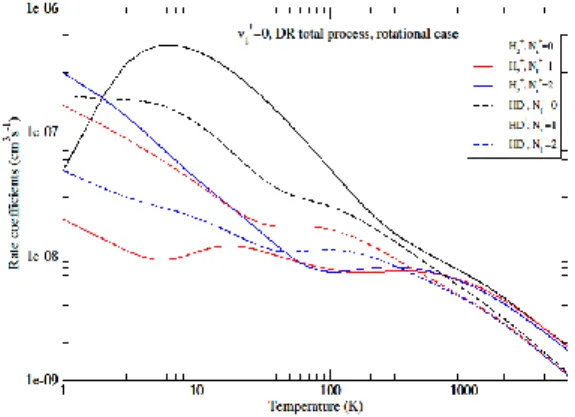Journal of Physics: Conference Series
PAPER • OPEN ACCESS
Dissociative recombination and vibrational excitation of molecular
cations with electrons: application to H 2 + , BeH + and their isotopomers
To cite this article: N Pop et al 2020 J. Phys.: Conf. Ser. 1412 172004
View the article online for updates and enhancements.
This content was downloaded from IP address 176.63.14.98 on 17/06/2020 at 04:42
Content from this work may be used under the terms of theCreative Commons Attribution 3.0 licence. Any further distribution of this work must maintain attribution to the author(s) and the title of the work, journal citation and DOI.
Published under licence by IOP Publishing Ltd
ICPEAC2019
Journal of Physics: Conference Series
1412 (2020) 172004IOP Publishing doi:10.1088/1742-6596/1412/17/172004
1
Dissociative recombination and vibrational excitation of molecular cations with electrons: application to H
2+, BeH
+and their isotopomers
N Pop1*, F Iacob2†, J Zs Mezei3, S Niyonzima4, O Motapon5 and I F Schneider6,7
1Dept. of Fundamental Physics for Engineers, Politehnica University, Timisoara, 300006, Romania
2Physics Faculty, West University of Timișoara, Timișoara, 300223, Romania
3Inst. of Nuclear Research of the Hungarian Academy of Sciences, Debrecen, H-4001, Hungary
4Department of Physics, Faculty of Sciences, University of Burundi, Bujumbura,1550, Burundi
5Department of Physics, Faculty of Sciences, University of Douala, 24157, Cameroon
6Laboratoire Ondes et Milieux Complexes, CNRS, Univ. du Havre, Le Havre, 76058, France
7Laboratoire Aimé Cotton, CNRS, ENS Cachan and Univ. Paris-Sud, Orsay, 91405, France
Synopsis Cross sections and Maxwell rate coefficients for the low-energy reactive collisions of electrons with Hydrogen and Beryllium hydride cations will be presented, as well as a discussion on the major relevant mecha- nisms and features – direct/indirect process, ro-vibronic couplings, ro-vibrational dependence.
Using a stepwise method based on the Multi- channel Quantum Defect Theory (MQDT) [1], cross sections and Maxwell rate coefficients have been obtained for dissociative recombina- tion (DR), elastic collisions (EC), vibrational excitation (VE, inelastic collisions), vibrational de-excitation (VdE, super-elastic collisions) of H2+ and HD+ for numerous ro-vibrational states of the ion [2, 3].
A very good agreement is found between our results and other computations, as well as with experiment. These results will complete the existing data-bases for electron-impact collision processes.
We have expanded our studies on BeH+ [4]
to BeD+ [5] and BeT+[6] cations. A complete set of vibrationally resolved rate coefficients for BeT+ cation reactive collisions with electrons below the ion dissociation threshold will be provided.
The resulting data are useful for the model- ing of the kinetics of the Early Universe and of the magnetic-confinement-fusion-edge plasma in JET and, later, in ITER.
Figure 1. Dissociative recombination Maxwell rate coefficients of H2+ and HD+ in ro-vibrational states Ni+=0-2, vi+= 0.
References
[1] Jungen Ch 2011 Handbook of High Resolu- tion Spectroscopy, Wiley & Sons, New York, 471
[2] Motapon O et al 2014 Phys. Rev. A 90 012706 [3] Epée Epée MD et al 2015 MNRAS 455 276–
281
[4] Niyonzima S et al 2017 Atomic Data and Nuclear Data Tables 115-116 287
[5] Niyonzima S et al 2018 Plasma Sources Sci.
Technol. 27 025015
[6] Iacob F et al 2019 AIP 2071(1) 020007
_________________________________________________________
* E-mail: nicolina.pop@upt.ro
† E-mail: felix.iacob@e-uvt.ro
